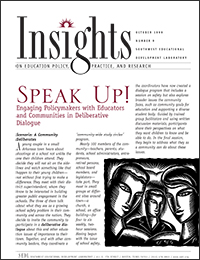Implementation Issues to Consider
Recruiting a diverse representation of community members, including groups traditionally underrepresented, is essential if any education issue is to be examined from all sides.
A well-designed and successfully implemented deliberative dialogue process can help expose community members, educators, and education policymakers to diverse perspectives, and encourage open and thorough dialogue on issues and solutions. A poorly implemented dialogue program may result in something less than an open, inclusive, deliberative dialogue, or may yield unintended consequences. The essential elements of using deliberative dialogue to engage the public in education may introduce factors community leaders should consider before launching such an effort.
- Dialogue Models—How a community organizes a deliberative dialogue effort will depend on which model it chooses. That choice, in turn, depends on the community’s needs and capacity. Who will be involved, how much time the community can invest, what kinds of issues they want to address, and what the community hopes to achieve are all important considerations in selecting the most appropriate model.
Most importantly, community members must be ready and willing to come together in dialogue about an issue that affects them. Deliberative dialogue cannot be done to a community. The community needs to want to do it and be willing to commit the time and energy to make the program successful. In addition, organizers will need to be careful to remain faithful to the process. Knowing what the essential elements or principles of each model are and ensuring they are respected in the program, will help protect against unproductive or negative results. (See the table What Are Some Deliberative Dialogue Models? to learn more about some models and to find help getting started.) - Inclusivity—Deliberative dialogue organizers seek to recruit participants representing the range of racial, ethnic, age, gender, socioeconomic, work, and civic groups present in
the community. Recruiting a diverse representation of community members, including minority groups that may traditionally have been under-represented, is essential if an education issue is to be examined from all sides. Individuals from every sector of the community can offer unique perspectives and creative ideas for approaching community issues. Their support, assistance, and resources will often be instrumental in carrying out resolutions to problems that affect them. The key to achieving this diversity is involving representatives of every major stakeholder and demographic community group in all stages of the program. - Organizing—For most deliberative dialogue efforts to be effective, a community should have one or two people who will serve as the central coordinator(s) responsible for seeing that things run smoothly. The study circle process used in the Arkansas scenario required coordinators with the time, skills, neutrality, and credibility to be able to reach out to all corners of the community to locate and recruit collaborators, volunteers, resources, meeting sites, facilitators, and participants. The coordinators were then able to lead a team of trusted community leaders and representatives who could gain broad-based local support for the program.
- Implementation—Several important steps will take place before the deliberative dialogue begins. They will vary by model, but may include:
- Deciding on or creating the discussion materials that will guide the dialogue. A model like the community-wide study circle process offers the option for the community to frame its own education issue for discussion in a way that will be inviting to a broad representation of the community.
- Finding capable and objective facilitators and ensuring they are trained to carry out their critical role effectively.
- Finding non-threatening, convenient, and comfortable locations for deliberative dialogue groups to meet.
- Arranging training sessions for facilitators.
- Working with media and community leaders to publicize the program and recruit participants from all sectors of the community.
- Timing the deliberative dialogue so that all major voices in the community can be present and be heard.
- Resources—In addition to human resources, several of the implementation steps may require financial or material resources. These can be donated or funded by individuals and organizations in the community. Obtaining grant money (e.g., from foundations, government entities) may facilitate implementation of a dialogue program, especially in rural areas with access to fewer businesses or individuals from whom they might get donations.
- Results—Although the main purpose of most deliberative dialogue efforts is to achieve mutual understanding of different viewpoints on an issue, they can also lead to action. Some deliberative dialogue models incorporate structures for moving to action or planning next steps. Others leave it up to participants to continue efforts begun in a dialogue. If action is an intended outcome, coordinators may want to set up a process for taking suggestions and ideas arising from the dialogues, creating tasks, and convening community members interested in taking on some of these tasks themselves.
Another intended result may be to influence policy, in which case the program will probably need to include a process for recording and summarizing what is said in the sessions. Coordinators or participants may consider submitting a report to city or state policymakers that describes the deliberative dialogue and lays out specific suggestions participants made. A written summary of the discussions may also be desirable for participants as a personal record of what they discussed and learned, as well as for non-participants who are interested in the issue.
Next Page: Conclusion

